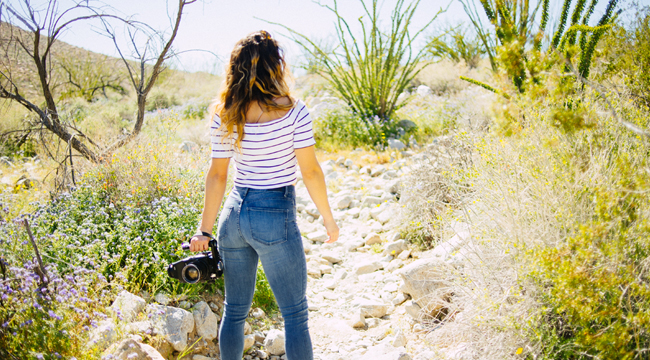
The videos on social media looked apocalyptic last fall — California was on fire. The air was thick with smoke, the hills were red and smoldering. During Northern California’s Camp Fire, reports came in that the region was suffering from the worst air quality in the world.
It wasn’t quite the apocalypse, but the fires were incredibly destructive. In 2018, more of California burned than ever before in recorded history — with more than 1.8 million acres lost to 8,054 fires that year, as reported by the National Interagency Fire Center. Camp Fire left 85 people dead and 18,804 structures destroyed. When coupled with the calamity of other large blazes, like the Woolsey Fire and the Mendocino-Complex fire, the overall damage proved enormous.
The effects are still being felt, and as spring comes to a close — and hiking, camping, and National Park visiting begin to rev up for the summer — it’s important to consider the long-term effects of these natural disasters. How are the hardest hit areas in the state recovering? With so much destruction, are the affected parks even worth a visit? Or are they still just black, ash-filled wasteland?
“When the rains came, we had black hills everywhere,” Dr. Martha Witter, a fire ecologist for the National Park Service, says, “but a lot our area converted from shrublands to non-native annual grasslands. So when we got the rain this year we soon had emerald green hills.”
Dr. Witter’s home base is in the Santa Monica Mountains National Recreation Center. This park, in particular, was hit hard by the Woolsey Fire in November. More than 88% of the land within the park boundary burned, scorching more acres throughout the park than ever before in recorded history. Still, with a climate adapted to wildfire, life is quickly returning to the area.
“Our park crew has been doing really well,” Witter says. “A lot of people are working very hard and many areas have opened back up already. People are getting back into the park, and things are coming together. They finished one of the last sections of the back end trail recently, which is open again.”
As we approach prime travel season, here’s why you should head back to Crater Lake in Oregon, Yosemite in California, Yellowstone in Wyoming, and scores of other parks affected by 2018’s fires.
It’s safe.
Immediately after a fire, a burned area emergency response team — including foresters, hydrologists, and geologists — is dispatched to assess hazards to the trails.
“Those teams go out and inspect the trails and certainly identify which areas are dangerous and need to be closed until they can be cleaned up,” Witter says. “There’s a lot of activity that goes on in the aftermath of a fire.”
The response team manages everything from making sure no trees have become hazardous to predicting what soil will become loose or dangerous after rainfall to replacing damaged signs. Additionally, experts are employed to make sure every trail is safe before being reopened to the public. (That said, if a trail is not open yet, there’s a reason. Don’t ignore closure signs.)
There is tons of regrowth to witness.
“Right now, we also have probably the most spectacular crop of flowering mustard plants you have ever seen,” Witter says. “So now, when you drive through the mountains, you’re seeing just amazing fields of gold flowers.”
Additionally, the Santa Monica mountains have seen fire poppies spring up, which are rare. They come from dormant seeds, which may be there for years, and need smoke to germinate. But if you want to catch any of the blooms, visit fast.
“They are just about to stop flowering and then they’re going to dry up,” Witter says of the various spring flowers. “And we’re going to have massive stands of big stalks for the summer.”
This is a chance to see the lifecycle take on interesting permutations and changes in the wake of destruction.
In parks that collect fees, your visitation money helps with recovery.
https://www.instagram.com/p/Bwao-3Vhc8D/
According to the National Park Service, 80 percent of your park fee stays in the park you visited. This means that for parks that specifically need extra support, just going and giving them money helps advance the recovery process. The other 20 percent of your entrance fee goes to help parks that don’t collect money, like the Santa Monica Mountains Recreation Area.
It keeps money flowing into surrounding areas.
https://www.instagram.com/p/BwOABE9Dz1Y/
“These fires, they have a big impact,” Witter says. “They have a big impact on the natural system, but they also have a big impact on the local communities and people who live in these areas. The people who are impacted by the Woolsey fire, they have a long road ahead of them to get back their homes.”
Supporting the local businesses nearby affected parks — restaurants, wineries, hotels — allows you to enjoy incredible travel experiences while also giving your money to those still rebuilding their lives after the devastating effects of wildfires. In most cases, you’re helping to prop up small-town economies that aren’t able to sustain a stagnant tourist season.
In good news for you, these small park adjacent towns are often home to fantastic diners, fascinating thrift shops, and quirky attractions. They’re definitely worth your time.
A note about responsible visiting:
Stay on marked, open trails because the parks are especially fragile right now.
“If you start walking off the trail, you’re going to disturb seed bank,” Witter says. “A lot of our slopes are steep and the soils are erodible. As people walk off trail, you disturb the soil and things slough down. You kill those little plants that are germinating and coming up that do get soil protection. The trails have been checked out, so they are safe places to stay.”
Of course, it should go without saying that you should pack out all of your waste and otherwise treat these fragile ecosystems with the care they deserve. Follow these simple guidelines and you’re sure to have a fantastic time while supporting recovery in our nation’s most vital ecosystems.






